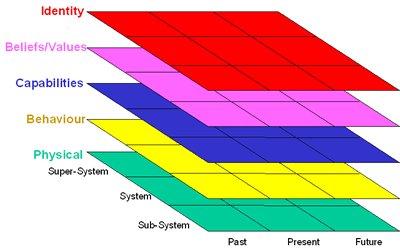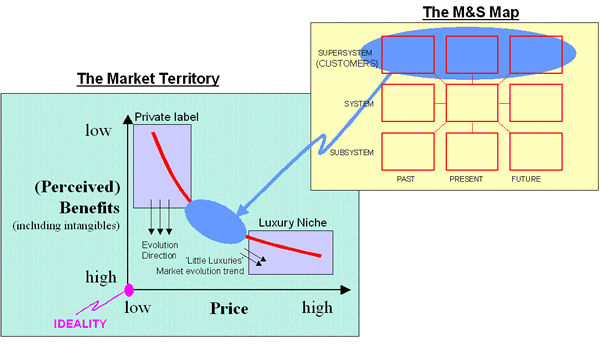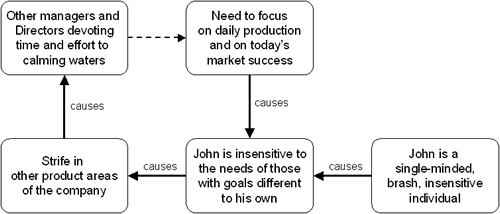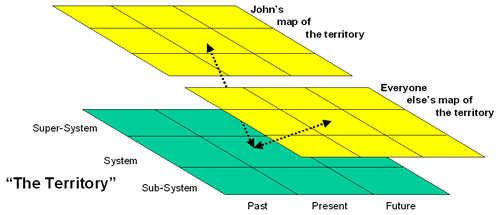
Darrell Mann
Industrial Fellow, University of Bath
Bath, BA2 7AY, UK
Phone: +44 (1225) 826465
Fax: +44 (1225) 826928
E-mail: D.L.Mann@bath.ac.uk
Introduction
In the last article we discussed some of the problems that can occur when we place ourselves ‘outside’ the 9 windows of the system operator, and how we can overcome those problems. In this article, we look at why this separation takes place and how our understanding of this ‘why’ can influence a range of problem and opportunity situations. In examining this situation, we will also see how TRIZ can benefit by integrating similar but in many ways more fully developed tools from Neuro-Linguistic Programming (NLP), and how this integration can, in turn, influence how we define and solve problems.
Another Dimension
We use an isometric view of the classical 9 Windows - as illustrated in Figure 1 - to begin examining what might happen when we follow the advice of the TRIZ geometric evolution trend, and move out of the two-dimensional model perspective and begin to actively use the third dimension.

Figure 1: Isometric View Of The Classic 9-Windows
A useful first question, then, might be, what can we usefully use this third dimension to express? A very good answer comes from NLP and the work of Robert Dilts (1) who first drew a version of the picture reproduced in Figure 2. If the classical 9 windows describe a SPACE - TIME plane, then Dilts suggested that the third plane should describe the different levels of human awareness. The first plane represents physical actuality. Successive planes then represent a hierarchy of awareness of the way we perceive and are affected by that physical reality, from first the way we behave in response to the actuality, right up to how our identity is affected by the actuality.

Figure 2: Turning The 9-Windows Into 45 Windows
A detailed discussion of the deep philosophical issues potentially raised by this picture is somewhat beyond the scope of this article; the reference is a far better next step for anyone interested. We, on the other hand will see what we might extract from the image that might help us in a practical problem solving sense.
(By way of a short intrusion, however, Dilts actually uses first, second and third person to represent what the system operator defines as sub-system, system and super-system respectively. This too can add an interesting perspective to the way we use the 9-Windows, albeit one also beyond the scope of this article.)
Many engineers are instinctively comfortable with the 9-windows, ‘thinking in time and space’ idea. Indeed, the design of physical things is highly amenable to this kind of world-view. Many management and ‘people’ problems, on the other hand are not so amenable to successful treatment by such a two-dimensional perspective (this is not to say that engineers make bad managers of course!). Such ‘people’ related problems demand that all of the issues associated with human behaviour have to be considered if we are going to successfully define and solve the real problem. In the NLP view, this means looking at all five levels. In terms of management type problems, just using two would represent a significant advance on the way most problems are viewed and dealt with today.
The Map and The Territory
Using the bottom two of the five system operator ‘levels’ - the ‘physical’ plane and the ‘behaviour’ plane (Figure 3) - should straightaway get us to recognize that potential for differences between the ‘actual’ and our perception of that actual. In more common parlance, the two planes represent the ‘territory’ and a ‘map’; the territory is what actually exists, while the map represents an opinion of what the territory looks like. Sometimes these two things are closely aligned, and sometimes they are not. When they are not, we have the basis of a contradiction. And once we have a contradiction, we have the ability to use TRIZ and other tools to help improve the situation.

Figure 3: The Map Is Not The Territory - Difference Between Physical Plane and Our Perception of It
Common ‘Map versus Territory’ Differences
The management literature is literally full to brimming with examples of contradictions emerging as a result of differences between map and territory. A particularly fine collection of examples may be found in the ‘decoding the corporate culture’ chapter in Reference 2. Author Eileen Shapiro describes the ‘internal game’:
| Espoused Rule (‘the Map’) | Real Rule (‘the Territory’) |
| ‘Quality comes First’ | ‘Ship product no matter what’ |
| ‘Never sell the customer something they don’t need’ | ‘Get the order; whoever gets most sales gets the biggest bonus’ |
| ‘We take the long-term view of our businesses’ | ‘Miss your quarterly budget and you’re dead meat’ |
| ‘We have an open environment speak up if you have a concern’ | ‘Accentuate the positive, hide the negative (unless you have a death wish)’ |
| ‘Developing people is one of our top priorities’ | ‘Managers who spend time developing their people are weaklings and aren’t tough enough to be in the job’ |
| ‘Improve efficiency…’ | ‘…and then we can cut jobs’ |
Awareness of the ‘internal game’ contradictions is not a solution of course; but recognition of the map-territory contradictions is at least a start.
Marks and Spencer
M&S have traditionally positioned themselves at the high-end of the high street chain store market. The map of their customer base has traditionally consisted of the aspirant middle-class family, and their competitors are other high street chains. In terms of the classic benefits versus price trade-off of the retail sector, they hold a solid middle-ground position.
Unfortunately in recent times, it has become apparent that the benefits-versus-price map for high-street stores - the map drawn by M&S - is somewhat different from the substantially bigger retailing benefit versus price territory. The difference is highlighted in Figure 4.
By no means uniquely - in fact we can observe very similar maps drawn by companies in a variety of markets from household to bodycare, from automobiles to airlines - the territory turns out to be a threat to the middle ground business. In the case of M&S, the territory actually also contains private-label goods at the low-price end of the benefits-price spectrum, and a number of niches, but most notably ‘little luxuries’ at the other end (see Reference 3 for more detailed discussion of this trend). In this bigger picture context, M&S is actually a rather small player, and, unless it recognizes the difference between their map and the territory, will get smaller as the private label and ‘little-luxury’ players gradually encroach further and further onto the M&S map as all associated trends say they will.

Figure 4: M&S - The Map Versus The Territory
(the blue oval is taken to represent the M&S super-system in its most general sense in terms of past, present and future definitions of time)
(A simple yet surprisingly effective remedy to the type of situation M&S now finds itself in is to use Principle 13 and ask the question ‘who doesn’t buy our products?’ The roots of increased market share usually exist outside the existing customer base.)
John - The Insensitive Line Manager
By way of another example of the problems that can be caused by the differences between map and territory, we look again at a well known TRIZ case study - the insensitive line manager problem first discussed in Reference 4. Essentially the problem comes about as a result of the causal map described in Figure 5.

Figure 5: The Insensitive Line Manager
The core conflict is that John channels all resources under his control towards meeting the group’s goals but he does this in a style that demoralises and renders ineffective other organisational goals. The previous TRIZ analysis detailed in Reference 4 presents a rather crude application of Inventive Principles to try and solve the contradiction ‘John should be present and not-present’. As subsequently discussed in Reference 5, stronger solutions will emerge by obtaining a better understanding of the root causes underlying the contradiction. It is suggested here that understanding of the problem can be further improved by recognising the differences between not just ‘map’ and ‘territory’, but also that different participants draw different maps. The point is illustrated in Figure 6 below.

Figure 6: The Insensitive Line Manager - Multiple Maps of One Territory
Given this picture, it should become possible to provide a basis for allowing everyone involved in the problem to see what is happening. It also helps us to identify not just the ‘John should be present and not-present’ contradiction, but also other - perhaps more appropriately tackled - contradictions like John’s map versus the territory, and everyone else’s map(s) versus the territory. Given the scenario, for example, in which the map versus territory picture is used to point out to John that the ‘optimization’ of his part of the business has a negative part on other parts of the other business with potentially net negative effect, it is difficult to see how he could continue doing what he is doing - certainly if his wish to do his best for the organisation is true. Rather than using the issue to berate John, the map-versus-territory concept also presents the opportunity to let him see a ‘bigger-picture’ view of the total business - i.e. the situation can be resolved in a win-win manner.
Discussion
In its original form, the 9-Windows system operator, whether intentionally or otherwise, separates us from the problem; we are encouraged to see it from ‘outside’ each of the windows; we look into the windows. This outsider’s perspective can be very useful, but what we have discussed here is that the outsider’s perspective is a map of a territory - and is therefore coloured by personal perspectives.
Different people will draw different maps of the territory. ‘Different maps’ represent the root of disagreement and contradiction. Awareness of these differences - through awareness of a third dimension in the system operator - offers at least the potential of better understanding of how conflicts arise, and thus how we might apply TRIZ and other tools to resolve them.
In the final installment of this series of articles exploring the system operator, we will be examining how some other non-TRIZ tools can be integrated with the 9-Windows concept to the mutual benefit of users of both TRIZ and those non-TRIZ tools.
References